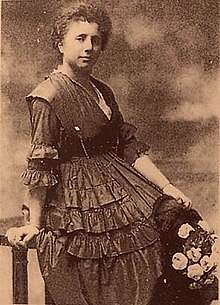Margherita Sarfatti

Margherita Sarfatti (born April 8, 1880 in Venice ; died October 30, 1961 in Cavallasca ) was an Italian writer , Mussolini's lover and founder of the Novecento artist group .
Life
Margherita Grassini comes from a wealthy Jewish family of lawyers. She was raised by private tutors. Captured by socialist ideals at a young age, she fled her parents' house on the Grand Canal in Venice at the age of 18 and married Cesare Sarfatti, a 13-year-old lawyer from Padua . In 1902 the couple moved to Milan . She later became an editor of the daily Il popolo d'Italia, founded by Benito Mussolini in 1914 . Sarfatti, although married, became Mussolini's lover and adviser. Her Milan salon was a meeting place for the city's intellectuals and artists in the 1920s.

In 1922 she founded the “ Gruppo del Novecento ” together with the gallery owner Lino Pesaro and the artists Anselmo Bucci , Leonardo Dudreville , Achille Funi , Gian-Emilio Malerba , Pietro Marussig , Ubaldo Oppi and Mario Sironi , which in 1923 moved to the gallery Pesaro presented her works for the first time in Milan . She countered the accusation of other artists that Sarfatti was trying to establish his own fascist art movement with this group by inviting all of Italy's major painters and sculptors to participate in the next major exhibition in 1926 .
Widowed since 1924, she published a biography of Mussolini in England in 1925 under the title The life of Benito Mussolini , which was also published in Italy the following year under the title Dux . The book was a huge success and has been translated into numerous languages. The German edition first appeared in 1926 under the title Mussolini. Biography. According to autobiographical documents .
When Italy was at war in Ethiopia and it was decided to introduce racial laws , Margherita Sarfatti emigrated to Argentina in 1938 and was therefore not involved in the downfall of the regime . She has also worked as a journalist in Montevideo .
She returned to Italy in 1947, where she lived in her country house in Cavallasca near Como until her death.
additional
- Margherita Sarfatti is a relative of the well-known lamp designer Gino Sarfatti .
- Her older sister Nella and her husband Paolo Errera were murdered in the Auschwitz concentration camp in April 1944 .
Works
- together with Benito Mussolini: The Life of Benito Mussolini , 1925. New edition 2004 under ISBN 1-4179-3962-1
- Dux , Mondadori 1926 (German Mussolini. Life story. Based on autobiographical documents , Leipzig 1926)
- Storia della pittura moderna , P. Cremonese 1930
- Casanova contro Don Giovanni , Mondadori 1950
- Acqua passata , Cappelli 1955
- [Autobiography], in: Elga Kern (Hrsg.): Leading women in Europe . In 25 self-descriptions. New episode. Munich: E. Reinhardt, 1930, pp. 108-115
literature
- Philip Cannistraro and Brian R. Sullivan: Il Duce's Other Woman: The Untold Story of Margherita Sarfatti, Mussolini's Jewish Mistress. 1993, ISBN 0-688-06299-7 .
- Simona Urso: Margherita Sarfatti. Dal mito del Dux al mito americano. 2003, ISBN 88-317-8342-4 .
- Karin Wieland: The Duce's lover. The life of Margherita Sarfatti and the invention of fascism. 2004, ISBN 3-446-20484-9 .
- Marianne Brentzel and Uta Ruscher: Margherita Sarfatti: “I was wrong? What the heck. ”Jewess. Patroness. Fascist. 2008, ISBN 3-855-35042-6 .
- Daniel Gutman: El amor judío de Mussolini. Margherita Sarfatti del fascismo al exilio. Lumière, Buenos Aires, ISBN 987-603-017-5 .
- Françoise Liffran: Margherita Sarfatti: L'égérie du Duce. Le Seuil, coll. «Biography», Paris 2009, ISBN 978-202098353-2 .
Web links
- Literature by and about Margherita Sarfatti in the catalog of the German National Library
- A caricature by David Levine
- The Jewish mother of Fascism by Saviona Mane in Haaretz
- Uta Ruscher on Margherita Sarfatti
- FemBiography Margherita Sarfatti
- Margherita Sarfatti on architecture (English)
- The Jewess who was Mussolini's muse In: SRF from September 25, 2018
- Exhibition at the Museo del Novecento in Milan. September 21, 2018 to February 24, 2019
Individual evidence
- ^ Heike B. Görtemaker : Hitler's court. The inner circle in the Third Reich and after. CH Beck, Munich 2019 ISBN 978-3406735271 , p. 238.
- ↑ Mussolini's Jewish lover who lived in Montevideo (in Spanish)
| personal data | |
|---|---|
| SURNAME | Sarfatti, Margherita |
| BRIEF DESCRIPTION | Italian writer, Mussolini's lover |
| DATE OF BIRTH | April 8, 1880 |
| PLACE OF BIRTH | Venice |
| DATE OF DEATH | October 30, 1961 |
| Place of death | Cavallasca |
